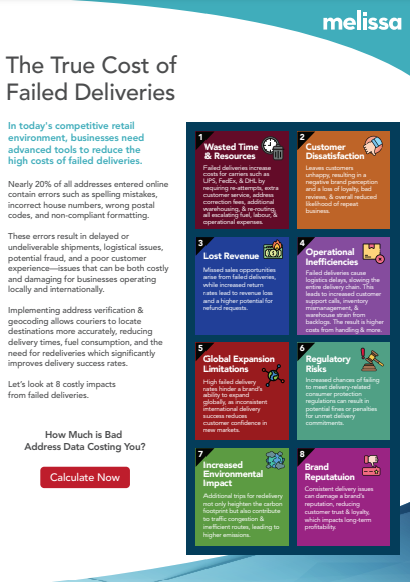
In the rapidly evolving world of e-commerce, delivery has become the frontline of the customer experience. As consumer expectations for fast, seamless, and inexpensive delivery grow, one of the most critical yet challenging aspects of logistics is last-mile delivery—the final leg of a package’s journey from a distribution hub to the customer’s doorstep.
While this may seem like a straightforward process, last-mile delivery is fraught with hidden challenges that can significantly impact both the cost-efficiency and customer satisfaction of an e-commerce business. Let’s explore some of these hidden challenges and why they matter more than ever.
1. Address Accuracy and Verification
Ensuring that delivery addresses are accurate and complete is a common but often overlooked challenge. Incorrect addresses lead to delivery delays, failed deliveries, or even lost packages, creating frustration for customers and increased operational costs for e-commerce companies.
The importance of address verification is critical in last-mile delivery. Without it, businesses are exposed to unnecessary risks, such as:
- Wasted Time and Resources: Couriers spend additional time attempting to find an accurate location or returning failed deliveries.
- Customer Dissatisfaction: Poor delivery experiences, especially failed deliveries, damage brand loyalty and drive customers to competitors.
- Increased Costs: Redelivery attempts, customer support interactions, and compensations add to the logistics costs.
2. Urban Congestion and Traffic
For urban deliveries, congestion and traffic are constant challenges that affect the efficiency of last-mile logistics. With growing urban populations, delivery trucks must navigate busy streets, narrow alleys, and limited parking spaces.
This slows down delivery times and can lead to inefficient routing, further increasing delivery costs. For e-commerce companies, finding innovative solutions to navigate urban landscapes—such as bike couriers, drones, or optimised route planning software—can reduce delays and improve operational efficiency.
3. Rural Delivery Complexities
While urban areas deal with congestion, rural and remote locations pose the opposite problem—distance. Delivering to rural areas often requires long routes to sparsely populated locations, leading to increased fuel and labour costs. In some regions, there may be poor road conditions or lack of detailed maps, which further complicates deliveries.
E-commerce companies often rely on third-party couriers to manage these deliveries, which can create inconsistencies in service quality and reliability. Handling rural last-mile logistics efficiently without overextending costs is a balancing act that many retailers struggle with.
4. Customer Availability
A hidden yet significant hurdle in last-mile delivery is customer availability. Failed deliveries due to customers not being at home when a package arrives can lead to delays, redelivery costs, and a negative customer experience. In fact, failed first-time deliveries are one of the biggest sources of inefficiency in last-mile logistics.
To overcome this, businesses are exploring alternatives such as:
- Delivery lockers: Secure, self-service pick-up points where customers can collect their packages at their convenience.
- Real-time delivery tracking: Allows customers to monitor their package’s journey and ensure they are home when it arrives.
- Flexible delivery windows: Providing customers with options to select a preferred time or day for delivery.
5. The Rise of Same-Day and Instant Delivery Expectations
In today’s competitive e-commerce landscape, next-day and same-day delivery have become the norm. This heightened expectation puts immense pressure on e-commerce companies to optimise their last-mile delivery networks.
However, offering same-day delivery comes with its own set of challenges:
- Increased Costs: Speeding up the last-mile delivery process often requires a greater number of warehouses or distribution hubs located closer to customers.
- Logistical Complexity: Coordinating a faster, more flexible delivery schedule while maintaining accuracy can be a major operational hurdle.
Geocoding plays a crucial role in alleviating these challenges by enhancing delivery accuracy and efficiency. By converting addresses into precise geographic coordinates, geocoding allows e-commerce companies to:
- Pinpoint Exact Delivery Locations: Reducing errors in address interpretation, ensuring packages are sent to the right location quickly, even in areas with complex or ambiguous addresses.
- Optimise Delivery Routes in Real-Time: With geospatial data, businesses can generate real-time route adjustments based on traffic and location, making same-day delivery more feasible and cost-effective.
Balancing the need for speed without compromising on delivery accuracy or incurring excessive costs is one of the most complex challenges for e-commerce businesses today, but geocoding helps bridge that gap by streamlining the last-mile process.
6. Sustainability and Environmental Impact
As consumers become more eco-conscious, the environmental impact of last-mile delivery is under increasing scrutiny. The use of delivery trucks contributes to traffic congestion and emissions, which can tarnish a brand’s reputation if not managed carefully.
Many companies are looking to sustainable solutions to mitigate the environmental effects of last-mile delivery. These include:
- Electric vehicles: Reducing carbon emissions and fuel costs.
- Consolidated deliveries: Grouping deliveries by area to reduce the number of vehicles on the road.
- Micro-fulfillment centres: Small, localised distribution hubs that shorten delivery routes, reducing the environmental footprint.
While these solutions help, they also require significant investment, making the trade-off between sustainability and cost a real challenge for many e-commerce brands.
7. The Challenge of Scalability
As e-commerce businesses grow, so do the complexities of scaling last-mile delivery operations. What works for a small business with local customers may not be feasible for a global e-commerce brand. Managing a complex, large-scale delivery network requires investment in advanced technologies, such as:
- AI-driven route optimisation: To plan the most efficient delivery routes based on real-time traffic data.
- Automation in warehouses: To ensure that orders are picked, packed, and dispatched as quickly as possible.
- Customer communication tools: To provide real-time delivery updates and improve transparency.
Address verification and geocoding can also play a critical factor in facilitating scalability by:
- Ensuring Address Accuracy at Scale: As businesses expand into new regions, address verification standardises and verifies addresses globally, ensuring that deliveries remain efficient and accurate regardless of the delivery location.
- Supporting AI and Route Optimisation: By feeding precise geospatial data into AI-driven logistics systems, geocoding helps scale route optimisation efforts, allowing businesses to manage larger delivery volumes without sacrificing speed or accuracy.
Without these technological investments, it becomes increasingly difficult for businesses to scale up while maintaining the same level of service. Address verification and geocoding, alongside AI and automation, plays a pivotal role in supporting scalable, efficient, and sustainable growth.
Conclusion: The Future of Last-Mile Delivery in E-Commerce
The hidden challenges of last-mile delivery in e-commerce require innovative solutions, constant adaptation, and investment in new technologies. Address accuracy, urban congestion, rural complexities, customer availability, rising delivery expectations, sustainability, and scalability all need to be tackled to ensure a seamless customer experience.
For e-commerce brands looking to stay ahead of the competition, solving these hidden challenges in last-mile delivery is not just a logistical necessity—it’s a crucial component of business success in the modern era. Investing in advanced address verification and geocoding systems, real-time tracking, sustainable practices, and AI-driven logistics will help retailers meet the growing demands of the last mile while maintaining efficiency and profitability.
As customer expectations continue to evolve, so too must the strategies that businesses employ to deliver the perfect last-mile experience.
The True Cost of Failed Deliveries Infographic
In today's competitive retail environment, businesses need advanced tools to reduce the high costs of failed deliveries. Read Infographic NowMelissa – The Address Experts
As the leader in address verification, Melissa combines decades of experience with unmatched technology and global support to offer solutions that quickly and accurately verify addresses in real-time, at the point of entry. Melissa is a single-source vendor for address management, data hygiene and pre-sorting solutions, empowering businesses all over the world to effectively manage their data quality.
